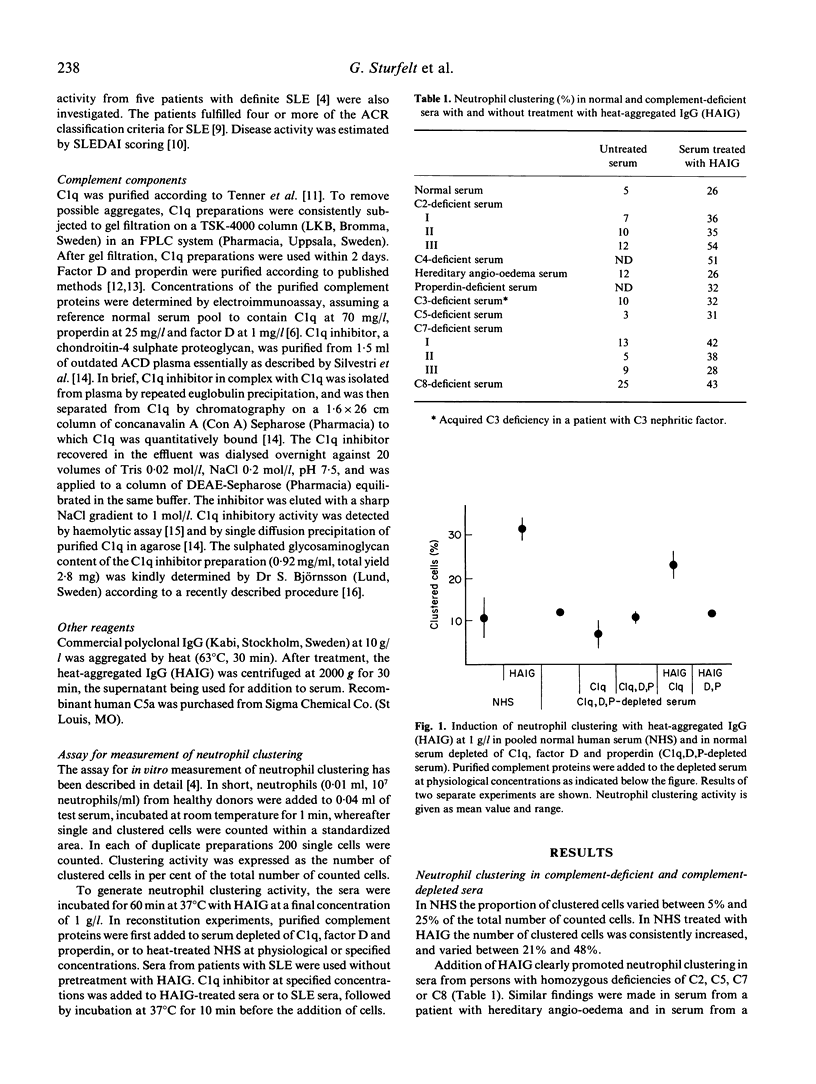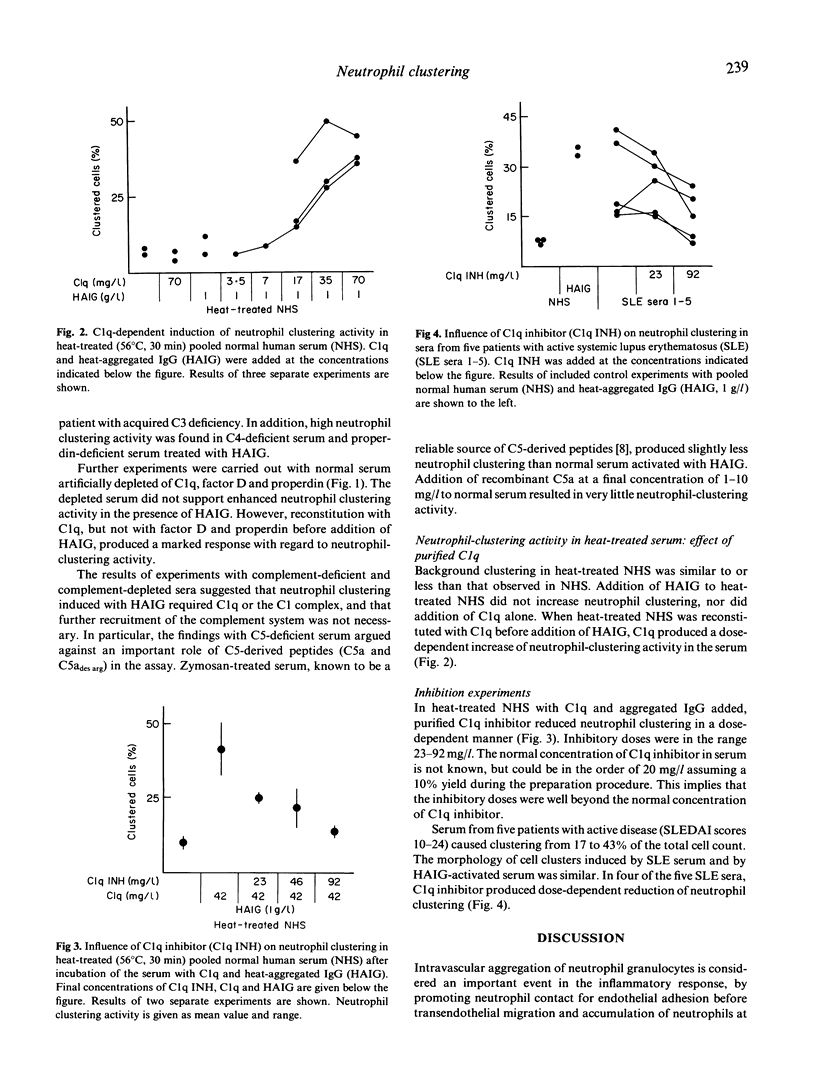Abstract
Clustering activity for neutrophil granulocytes was generated in pooled normal human serum (NHS) by incubation of the serum with preformed IgG aggregates, but not in heat-treated NHS (56 degrees C, 30 min), indicating that the function was complement-dependent. Judging from results of experiments with complement-deficient sera, and serum depleted of C1q, factor D and properdin, recruitment of the complement system beyond C1 was not required for induction of the activity. Zymosan treatment of NHS resulted in some neutrophil clustering activity, but recombinant C5a had a limited effect. C1q added to heat-treated NHS in conjunction with performed IgG aggregates supported neutrophil clustering in a dose-dependent manner. The serum C1q inhibitor, a chondroitin 4-sulphate proteoglycan known to interact with the collagenous part of C1q, clearly reduced neutrophil clustering in heat-treated NHS supplemented with C1q and IgG aggregates. The C1q inhibitor also reduced the inherent neutrophil clustering activity of some sera from patients with systemic lupus erythematosus (SLE). Neutrophil clustering activity in SLE serum was earlier shown to be inversely related to the number of circulating neutrophils in vivo. Although the precise mechanisms remain unclear, we propose that C1q-containing immunoglobulin complexes mediate neutrophil clustering through C1q receptors, and that this might contribute to pathogenesis of immune complex diseases such as SLE.
Full text
PDF




Selected References
These references are in PubMed. This may not be the complete list of references from this article.
- Abramson S. B., Given W. P., Edelson H. S., Weissmann G. Neutrophil aggregation induced by sera from patients with active systemic lupus erythematosus. Arthritis Rheum. 1983 May;26(5):630–636. doi: 10.1002/art.1780260509. [DOI] [PubMed] [Google Scholar]
- Arnaout M. A. Structure and function of the leukocyte adhesion molecules CD11/CD18. Blood. 1990 Mar 1;75(5):1037–1050. [PubMed] [Google Scholar]
- Arvieux J., Reboul A., Bensa J. C., Colomb M. G. Characterization of the C1q receptor on a human macrophage cell line, U937. Biochem J. 1984 Mar 1;218(2):547–555. doi: 10.1042/bj2180547. [DOI] [PMC free article] [PubMed] [Google Scholar]
- Batsford S. R. Cationic antigens as mediators of inflammation. APMIS. 1991 Jan;99(1):1–9. doi: 10.1111/j.1699-0463.1991.tb05110.x. [DOI] [PubMed] [Google Scholar]
- Björnsson S. Simultaneous preparation and quantitation of proteoglycans by precipitation with alcian blue. Anal Biochem. 1993 May 1;210(2):282–291. doi: 10.1006/abio.1993.1197. [DOI] [PubMed] [Google Scholar]
- Bombardier C., Gladman D. D., Urowitz M. B., Caron D., Chang C. H. Derivation of the SLEDAI. A disease activity index for lupus patients. The Committee on Prognosis Studies in SLE. Arthritis Rheum. 1992 Jun;35(6):630–640. doi: 10.1002/art.1780350606. [DOI] [PubMed] [Google Scholar]
- Chenoweth D. E., Cooper S. W., Hugli T. E., Stewart R. W., Blackstone E. H., Kirklin J. W. Complement activation during cardiopulmonary bypass: evidence for generation of C3a and C5a anaphylatoxins. N Engl J Med. 1981 Feb 26;304(9):497–503. doi: 10.1056/NEJM198102263040901. [DOI] [PubMed] [Google Scholar]
- Craddock P. R., Hammerschmidt D., White J. G., Dalmosso A. P., Jacob H. S. Complement (C5-a)-induced granulocyte aggregation in vitro. A possible mechanism of complement-mediated leukostasis and leukopenia. J Clin Invest. 1977 Jul;60(1):260–264. doi: 10.1172/JCI108763. [DOI] [PMC free article] [PubMed] [Google Scholar]
- Crockett-Torabi E., Fantone J. C. Soluble and insoluble immune complexes activate human neutrophil NADPH oxidase by distinct Fc gamma receptor-specific mechanisms. J Immunol. 1990 Nov 1;145(9):3026–3032. [PubMed] [Google Scholar]
- Daha M. R., Miltenburg A. M., Hiemstra P. S., Klar-Mohamad N., Van Es L. A., Van Hinsbergh V. W. The complement subcomponent C1q mediates binding of immune complexes and aggregates to endothelial cells in vitro. Eur J Immunol. 1988 May;18(5):783–787. doi: 10.1002/eji.1830180519. [DOI] [PubMed] [Google Scholar]
- Fehr J., Jacob H. S. In vitro granulocyte adherence and in vivo margination: two associated complement-dependent functions. Studies based on the acute neutropenia of filtration leukophoresis. J Exp Med. 1977 Sep 1;146(3):641–652. doi: 10.1084/jem.146.3.641. [DOI] [PMC free article] [PubMed] [Google Scholar]
- Ghebrehiwet B. C1q inhibitor (C1qINH): functional properties and possible relationship to a lymphocyte membrane-associated C1q precipitin. J Immunol. 1981 May;126(5):1837–1842. [PubMed] [Google Scholar]
- Ghebrehiwet B. Functions associated with the C1q receptor. Behring Inst Mitt. 1989 Jul;(84):204–215. [PubMed] [Google Scholar]
- Goodman E. B., Tenner A. J. Signal transduction mechanisms of C1q-mediated superoxide production. Evidence for the involvement of temporally distinct staurosporine-insensitive and sensitive pathways. J Immunol. 1992 Jun 15;148(12):3920–3928. [PubMed] [Google Scholar]
- Hammerschmidt D. E., Weaver L. J., Hudson L. D., Craddock P. R., Jacob H. S. Association of complement activation and elevated plasma-C5a with adult respiratory distress syndrome. Pathophysiological relevance and possible prognostic value. Lancet. 1980 May 3;1(8175):947–949. doi: 10.1016/s0140-6736(80)91403-8. [DOI] [PubMed] [Google Scholar]
- Harlan J. M. Leukocyte-endothelial interactions. Blood. 1985 Mar;65(3):513–525. [PubMed] [Google Scholar]
- Hashimoto Y., Ziff M., Hurd E. R. Increased endothelial cell adherence, aggregation, and superoxide generation by neutrophils incubated in systemic lupus erythematosus and Felty's syndrome sera. Arthritis Rheum. 1982 Dec;25(12):1409–1418. doi: 10.1002/art.1780251204. [DOI] [PubMed] [Google Scholar]
- Jonsson H., Sjöholm A. G., Mårtensson U., Laurell A. B., Sturfelt G. C1 subcomponent complexes and C2 cleavage in active systemic lupus erythematosus. Complement Inflamm. 1991;8(1):1–12. doi: 10.1159/000463172. [DOI] [PubMed] [Google Scholar]
- Jonsson H., Sturfelt G. A novel assay for neutrophil clustering activity of human sera: relation to disease activity and neutropenia in systemic lupus erythematosus. Ann Rheum Dis. 1990 Jan;49(1):46–50. doi: 10.1136/ard.49.1.46. [DOI] [PMC free article] [PubMed] [Google Scholar]
- Kaplan H. B., Edelson H. S., Friedman R., Weissmann G. The roles of degranulation and superoxide anion generation in neutrophil aggregation. Biochim Biophys Acta. 1982 Sep 13;721(1):55–63. doi: 10.1016/0167-4889(82)90023-4. [DOI] [PubMed] [Google Scholar]
- Kuypers T. W., Koenderman L., Weening R. S., Verhoeven A. J., Roos D. Continuous cell activation is necessary for stable interaction of complement receptor type 3 with its counter-structure in the aggregation response of human neutrophils. Eur J Immunol. 1990 Mar;20(3):501–508. doi: 10.1002/eji.1830200307. [DOI] [PubMed] [Google Scholar]
- Laurell A. B., Mårtensson U., Sjöholm A. G. C1 dissociation. Spontaneous generation in human serum of a trimer complex containing C1 inactivator, activated C1r, and zymogen C1s. J Immunol. 1987 Dec 15;139(12):4145–4151. [PubMed] [Google Scholar]
- Malhotra R., Thiel S., Reid K. B., Sim R. B. Human leukocyte C1q receptor binds other soluble proteins with collagen domains. J Exp Med. 1990 Sep 1;172(3):955–959. doi: 10.1084/jem.172.3.955. [DOI] [PMC free article] [PubMed] [Google Scholar]
- McCall C. E., De Chatelet L. R., Brown D., Lachmann P. New biological activity following intravascular activation of the complement cascade. Nature. 1974 Jun 28;249(460):841–843. doi: 10.1038/249841a0. [DOI] [PubMed] [Google Scholar]
- Medicus R. G., Esser A. F., Fernandez H. N., Müller-Eberhard H. J. Native and activated properdin: interconvertibility and identity of amino- and carboxy-terminal sequences. J Immunol. 1980 Feb;124(2):602–606. [PubMed] [Google Scholar]
- Ohmori H., Toyama S., Toyama S. Direct proof that the primary site of action of cytochalasin on cell motility processes is actin. J Cell Biol. 1992 Feb;116(4):933–941. doi: 10.1083/jcb.116.4.933. [DOI] [PMC free article] [PubMed] [Google Scholar]
- Peerschke E. I., Ghebrehiwet B. Platelet interactions with C1q in whole blood and in the presence of immune complexes or aggregated IgG. Clin Immunol Immunopathol. 1992 Apr;63(1):45–50. doi: 10.1016/0090-1229(92)90092-3. [DOI] [PubMed] [Google Scholar]
- Schwartz B. R., Ochs H. D., Beatty P. G., Harlan J. M. A monoclonal antibody-defined membrane antigen complex is required for neutrophil-neutrophil aggregation. Blood. 1985 Jun;65(6):1553–1556. [PubMed] [Google Scholar]
- Silvestri L., Baker J. R., Rodén L., Stroud R. M. The C1q inhibitor in serum is a chondroitin 4-sulfate proteoglycan. J Biol Chem. 1981 Jul 25;256(14):7383–7387. [PubMed] [Google Scholar]
- Sturfelt G., Johnson U., Sjöholm A. G. Sequential studies of complement activation in systemic lupus erythematosus. Scand J Rheumatol. 1985;14(2):184–196. doi: 10.3109/03009748509165503. [DOI] [PubMed] [Google Scholar]
- Sturfelt G., Linder C., Sjöholm A. G., Svensson B. Impaired monocyte motility in sera from patients with systemic lupus erythematosus. Acta Pathol Microbiol Immunol Scand C. 1983 Apr;91(2):151–158. [PubMed] [Google Scholar]
- Tan E. M., Cohen A. S., Fries J. F., Masi A. T., McShane D. J., Rothfield N. F., Schaller J. G., Talal N., Winchester R. J. The 1982 revised criteria for the classification of systemic lupus erythematosus. Arthritis Rheum. 1982 Nov;25(11):1271–1277. doi: 10.1002/art.1780251101. [DOI] [PubMed] [Google Scholar]
- Tenner A. J., Cooper N. R. Analysis of receptor-mediated C1q binding to human peripheral blood mononuclear cells. J Immunol. 1980 Oct;125(4):1658–1664. [PubMed] [Google Scholar]
- Tenner A. J., Cooper N. R. Stimulation of a human polymorphonuclear leukocyte oxidative response by the C1q subunit of the first complement component. J Immunol. 1982 Jun;128(6):2547–2552. [PubMed] [Google Scholar]
- Tenner A. J., Lesavre P. H., Cooper N. R. Purification and radiolabeling of human C1q. J Immunol. 1981 Aug;127(2):648–653. [PubMed] [Google Scholar]
- Tonnesen M. G., Anderson D. C., Springer T. A., Knedler A., Avdi N., Henson P. M. Adherence of neutrophils to cultured human microvascular endothelial cells. Stimulation by chemotactic peptides and lipid mediators and dependence upon the Mac-1, LFA-1, p150,95 glycoprotein family. J Clin Invest. 1989 Feb;83(2):637–646. doi: 10.1172/JCI113928. [DOI] [PMC free article] [PubMed] [Google Scholar]
- Truedsson L., Sturfelt G. Human factor D of the alternative pathway: purification and quantitation by enzyme amplified electroimmunoassay. J Immunol Methods. 1983 Oct 14;63(2):207–214. doi: 10.1016/0022-1759(83)90424-6. [DOI] [PubMed] [Google Scholar]
- Yuli I., Snyderman R. Light scattering by polymorphonuclear leukocytes stimulated to aggregate under various pharmacologic conditions. Blood. 1984 Sep;64(3):649–655. [PubMed] [Google Scholar]


